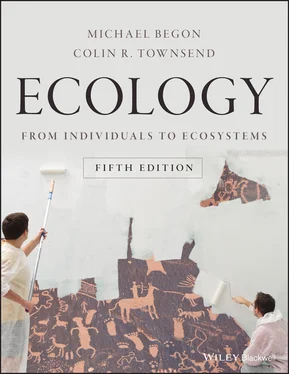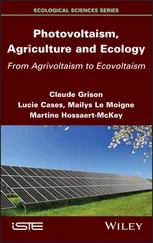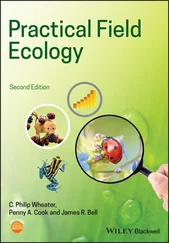A good example is provided by two species of cichlid fish in Nicaragua: the Midas cichlid Amphilophus citrinellus and the arrow cichlid A. zaliosus ( Figure 1.11a) (Barluenga et al ., 2006). These species coexist in the small, isolated Lake Apoyo (satisfying criterion 1), which is relatively homogeneous in terms of habitat, and of recent origin (less than 23 000 years). A. zaliosus is found nowhere else, while A. citrinellus occurs in many water bodies in the region, including the largest. A variety of behavioural (mate choice) and genetic evidence, including that from microsatellite DNA, indicates that the two species in Lake Apoyo are reproductively isolated from one another (satisfying criterion 2) and indeed from A. citrinellus in other lakes ( Figure 1.11b). Further genetic evidence from mitochondrial DNA (passed by mothers to their offspring) indicates that the cichlids of Lake Apoyo, of both species, had a single common ancestor arising from the much more widespread stock of A. citrinellus ( Figure 1.11c) (satisfying criteria 3 and 5). The common ancestor was a high‐bodied benthic species but A. zaliosus , the new elongated pelagic species, has evolved in less than 10 000 years. Now A. citrinellus and A. zaliosus in Lake Apoyo are morphologically distinct from one another and have substantially different diets: both feed on biofilm but A. citrinellus feeds more from the benthic environment (algae, insects and fish along the lake shore and bed) while A. zaliosus feeds more from open water and the surface (including winged insects; Figure 1.11d). There seems little doubt, therefore, that this speciation must have occurred sympatrically, presumably driven by the divergent selection to specialise on bottom‐feeding in the one case and on open water‐feeding in the other.
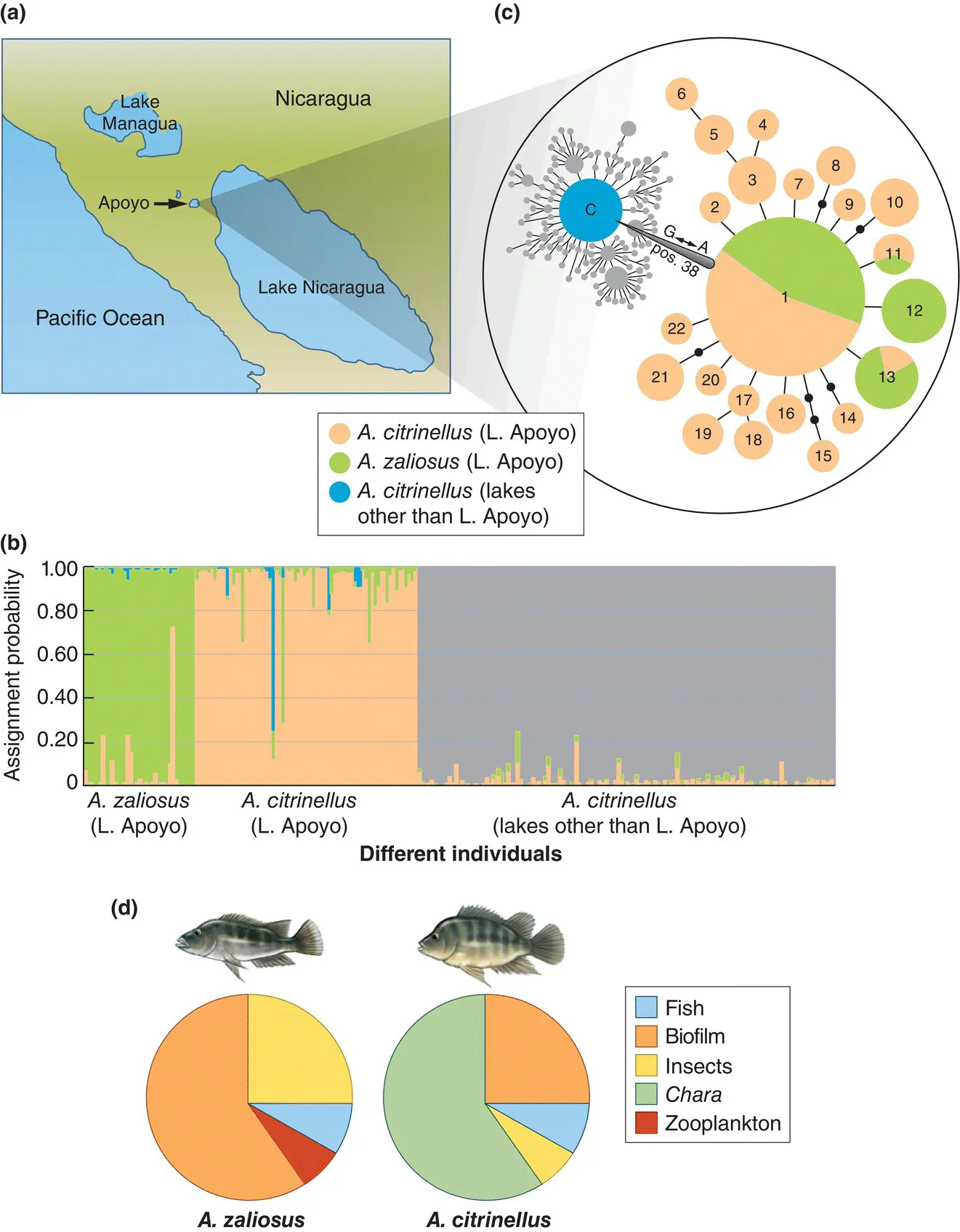
Figure 1.11 Sympatric speciation in the cichlid fish Amphilophus citrinellus and A. zaliosus.(a) The location of Lake Apoyo in Nicaragua. (b) The assignment of individuals to populations based on variation at 10 microsatellite DNA loci: A. zaliosus (green) and A. citrinellus (orange) from Lake Apoyo and A. citrinellus (blue) from other lakes. The clear separation of colours is indicative of partial or total reproductive isolation between them. (c) The relatedness network of 637 ‘haplotypes’ of mitochondrial DNA sequences from individual fish using the same colour coding as in (b). (A haplotype is a set of markers on a single chromosome that tend to be inherited together from a single parent.) The size of a circle reflects the frequency with which a particular haplotype was found. The most common haplotype in Lake Apoyo (‘1’) is distinguished from the most common A. citrinellus haplotype from elsewhere (‘C’) by a single mutation (base substitution of guanine by adenine at position 38), but all Lake Apoyo haplotypes, of both species, share this mutation, indicating their origin from a single common ancestor. (d) Stomach content analyses of the two species in Lake Apoyo. ( Chara is a multicellular alga.).
Source : After Barluenga et al . (2006).
where is sympatric speciation most likely?
Examples of species groups most likely to satisfy Coyne and Orr’s (2004) criteria are organisms with a strong, genetically determined fidelity to a habitat in which mating will occur, such as insects that feed on more than one species of host plant, where each requires specialisation by the insects to overcome the plant’s defenses, fish on coral reefs (and perhaps marine animals more generally; Bird et al ., 2012) and parasites (Santini et al ., 2012). And we have already seen how two lake fish conform to the scenario. Indeed, one of the most staggeringly rich examples of endemism has also been provided by cichlid fish: those of the East African Great Lakes, with more than 1500 endemic species in a relatively small, isolated geographic region. It remains to be discovered how important a role sympatric speciation plays in that case, and whether divergent selection to different niches is the main driving force.
sympatric speciation – divergence with gene flow or microallopatric speciation?
A final critical question is whether a case thought to have arisen by sympatric speciation is truly a result of species diverging while gene flow was occurring (sympatric) or merely ‘microallopatric’ speciation. A small‐scale geographic barrier (analogous to ocean habitat between islands) may occur, for example, as an underwater ridge in a lake. Moreover, host‐specific parasites and phytophagous insects might also have broadly overlapping geographic ranges and yet never encounter one another because of their distinct ecological niches. In other words, populations might overlap at a coarse grain if they occupy the same geographic region, but not co‐occur at a finer grain if they occupy different habitats within that region. Thus, whether populations are described as sympatric is somewhat at the discretion of the observer (Fitzpatrick et al ., 2008).
a mechanism for sympatric speciation: AITs?
It is easy to see how geographically isolated populations have diverged, because they are also reproductively isolated, but not so straightforward to conceive how assortative mating can evolve sympatrically in populations that are not geographically isolated but experience divergent selective pressures. This may occur via ‘automatic isolating traits’ (AITs). An example would be where a particular locus or set of loci interacts with the environment to express different mating behaviours under different environmental conditions, regardless of genotype, such as the timing of flowering in plants. For example, the most recent common ancestor of two sympatric sister Howea palms on the tiny Lord Howe Island, 600 km off the coast of Australia, may have exhibited different flowering times when growing in different soil types so that a difference in physiology elicited by environmental differences, rather than a difference in genotype, could have enforced mating fidelity by soil type rather than genotype and increased the likelihood that divergence was possibly despite broad‐scale sympatry ( Figure 1.12). Papadopulos et al . (2011) describe other examples of sympatric speciation of plants in the genera Metrosideros and Coprosma on Lord Howe Island. Further possible cases where AITs may operate include fish with colour polymorphisms, genes responsible for insect hybrid male sterility, and cases involving chemical signalling (Bird et al ., 2012).
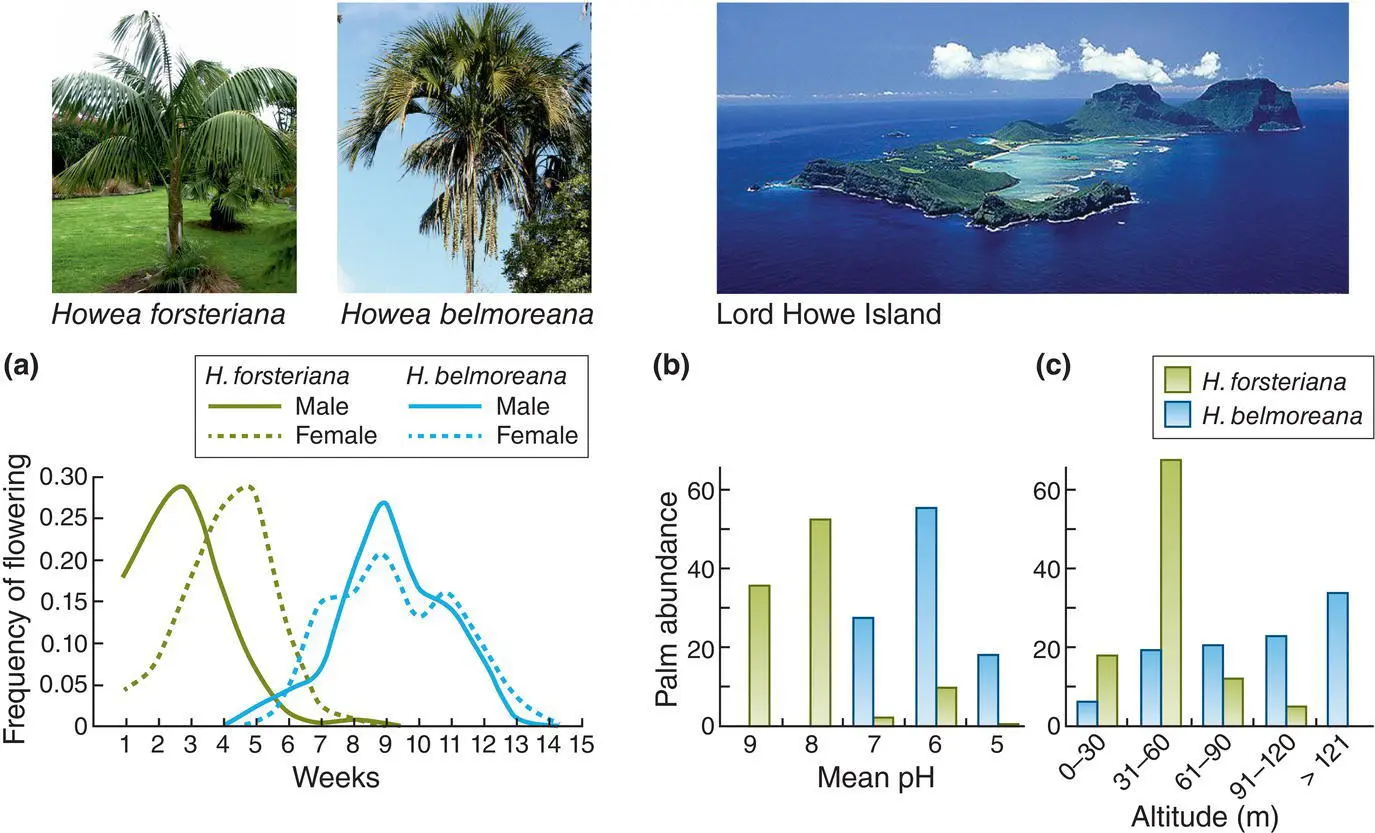
Figure 1.12 Sympatric speciation in Howea palms.Two species of Howea palm on the tiny and isolated Lord Howe Island off the coast of Australia. Howea forsteriana has straight leaves with drooping leaflets, while H. belmoreana has recurved leaves with ascending leaflets. ( H. forsteriana is now one of the world’s most widely traded house plants.) A comprehensive DNA‐based phylogenetic tree indicates that these are sister species with their closest relative, Laccospadix , on the Australian mainland. Molecular dating methods show the two Howea species diverged 1–1.92 million years ago, long after Lord Howe Island was formed by volcanic activity 6.4–6.9 million years ago. H. forsteriana diverged from its sister species (an ancestor of H. belmoreana ) by colonising widespread lowland calcarenite deposits. Extensive molecular evidence is consistent with Coyne and Orr’s criteria for sympatric speciation (see earlier). (a) H. forsteriana (green lines) flowers early in the flowering season, with male flowering (solid line) peaking 2 weeks before female receptivity (dashed line); H. belmoreana male and female flowering is synchronous but later in the season. (b) H. forsteriana occurs in soils of higher pH and (c) lower altitude than H. belmoreana .
Читать дальше
